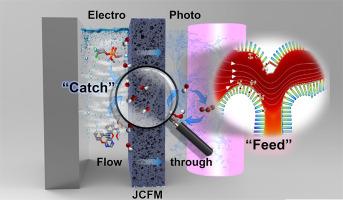当前位置:
X-MOL 学术
›
Water Res.
›
论文详情
Our official English website, www.x-mol.net, welcomes your
feedback! (Note: you will need to create a separate account there.)
“Catch-and-feed”: Janus catalytic flow-through membrane enables highly efficient removal of micropollutants in water
Water Research ( IF 11.4 ) Pub Date : 2024-11-09 , DOI: 10.1016/j.watres.2024.122778 Yuxin Zeng, Yaxuan Gao, Tao Guo, Lifeng Yin, Michael R. Hoffmann
Water Research ( IF 11.4 ) Pub Date : 2024-11-09 , DOI: 10.1016/j.watres.2024.122778 Yuxin Zeng, Yaxuan Gao, Tao Guo, Lifeng Yin, Michael R. Hoffmann

|
Micropollutants, due to their low concentrations, exceptional chemical stability, and profound toxicity, present a significant challenge in water treatment. While electrocatalysis and photocatalysis have shown promise as potential water purification techniques, their inherent limitations in mass transfer often result in elevated energy requirements and suboptimal efficiency. In this study, a Janus catalytic flow-through membrane (JCFM) was utilized to successfully remove two notorious micropollutants dichlorvos (DDVP) and azoxystrobin (AZX) from water based on the "catch-and-feed" strategy. This membrane adopts a ``sandwich'' configuration, comprising platinum-modified reduced titanium (Pt@rTO) as the electrocatalytic layer, porous titanium (Ti) as the current collector, and rTO as the photocatalytic layer. The JCFM exhibited remarkable performance, maintaining an •OH energy conversion efficiency of up to 20.12 nM and displaying catalytic activity (kJCFM = 6.97 × 10−4 s−1) in degrading AZX far superior to that of photocatalysis (kPC = 9.51 × 10−5 s−1) or electrocatalysis (kEC = 9.89 × 10−5 s−1) alone. It is evidenced that the Pt@rTO layer efficiently generates reactive oxygen species (ROS), which, along with the micropollutants, flow through the JCFM (“feed”), which strengthens mass transfer and facilitates efficient reactions within the confined space (“catch”). The ROSs then seep through the rTO layer, where they are reactivated by UV light radiation. The mechanism and the alternative reaction pathway of DDVP and AZX has also been proposed. In sequential testing, the JCFM achieved continuous and energy-efficient removal of micropollutants, exceeding 97.5 % over 200 h. The scale-up application of this technology has proven effective in the treatment of secondary biochemical effluent from municipal sewage, coking wastewater, and landfill leachate, achieving the concurrent degradation of various micropollutants.
中文翻译:

“捕捉和进料”:Janus 催化流通膜能够高效去除水中的微污染物
微污染物由于其低浓度、出色的化学稳定性和深毒性,在水处理中提出了重大挑战。虽然电催化和光催化已被证明是潜在的水净化技术,但它们在传质方面的固有局限性通常会导致能源需求增加和效率欠佳。在这项研究中,利用 Janus 催化流通膜 (JCFM) 根据“捕捉和喂养”策略成功地从水中去除了两种臭名昭著的微污染物敌敌畏 (DDVP) 和嘧菌酯 (AZX)。该膜采用“三明治”配置,包括铂改性还原钛 (Pt@rTO) 作为电催化层,多孔钛 (Ti) 作为集流体,rTO 作为光催化层。JCFM 表现出显着的性能,保持高达 20.12 nM 的 •OH 能量转换效率,并在降解 AZX 中表现出催化活性 (kJCFM = 6.97 × 10-4 s-1),远优于光催化 (kPC = 9.51 × 10-5 s-1) 或电催化 (kEC = 9.89 × 10-5 s-1)) 单独。事实证明,Pt@rTO层可以有效地产生活性氧 (ROS),活性氧与微污染物一起流经 JCFM(“进料”),从而加强传质并促进密闭空间内的高效反应(“捕获”)。然后 ROS 渗入 rTO 层,在那里它们被紫外光辐射重新激活。还提出了 DDVP 和 AZX 的机制和替代反应途径。 在连续测试中,JCFM 实现了连续和节能的微污染物去除,在 200 小时内超过 97.5%。该技术的放大应用已被证明可有效处理城市污水、焦化废水和垃圾渗滤液中的二次生化废水,实现各种微污染物的同步降解。
更新日期:2024-11-13
中文翻译:

“捕捉和进料”:Janus 催化流通膜能够高效去除水中的微污染物
微污染物由于其低浓度、出色的化学稳定性和深毒性,在水处理中提出了重大挑战。虽然电催化和光催化已被证明是潜在的水净化技术,但它们在传质方面的固有局限性通常会导致能源需求增加和效率欠佳。在这项研究中,利用 Janus 催化流通膜 (JCFM) 根据“捕捉和喂养”策略成功地从水中去除了两种臭名昭著的微污染物敌敌畏 (DDVP) 和嘧菌酯 (AZX)。该膜采用“三明治”配置,包括铂改性还原钛 (Pt@rTO) 作为电催化层,多孔钛 (Ti) 作为集流体,rTO 作为光催化层。JCFM 表现出显着的性能,保持高达 20.12 nM 的 •OH 能量转换效率,并在降解 AZX 中表现出催化活性 (kJCFM = 6.97 × 10-4 s-1),远优于光催化 (kPC = 9.51 × 10-5 s-1) 或电催化 (kEC = 9.89 × 10-5 s-1)) 单独。事实证明,Pt@rTO层可以有效地产生活性氧 (ROS),活性氧与微污染物一起流经 JCFM(“进料”),从而加强传质并促进密闭空间内的高效反应(“捕获”)。然后 ROS 渗入 rTO 层,在那里它们被紫外光辐射重新激活。还提出了 DDVP 和 AZX 的机制和替代反应途径。 在连续测试中,JCFM 实现了连续和节能的微污染物去除,在 200 小时内超过 97.5%。该技术的放大应用已被证明可有效处理城市污水、焦化废水和垃圾渗滤液中的二次生化废水,实现各种微污染物的同步降解。


















































 京公网安备 11010802027423号
京公网安备 11010802027423号